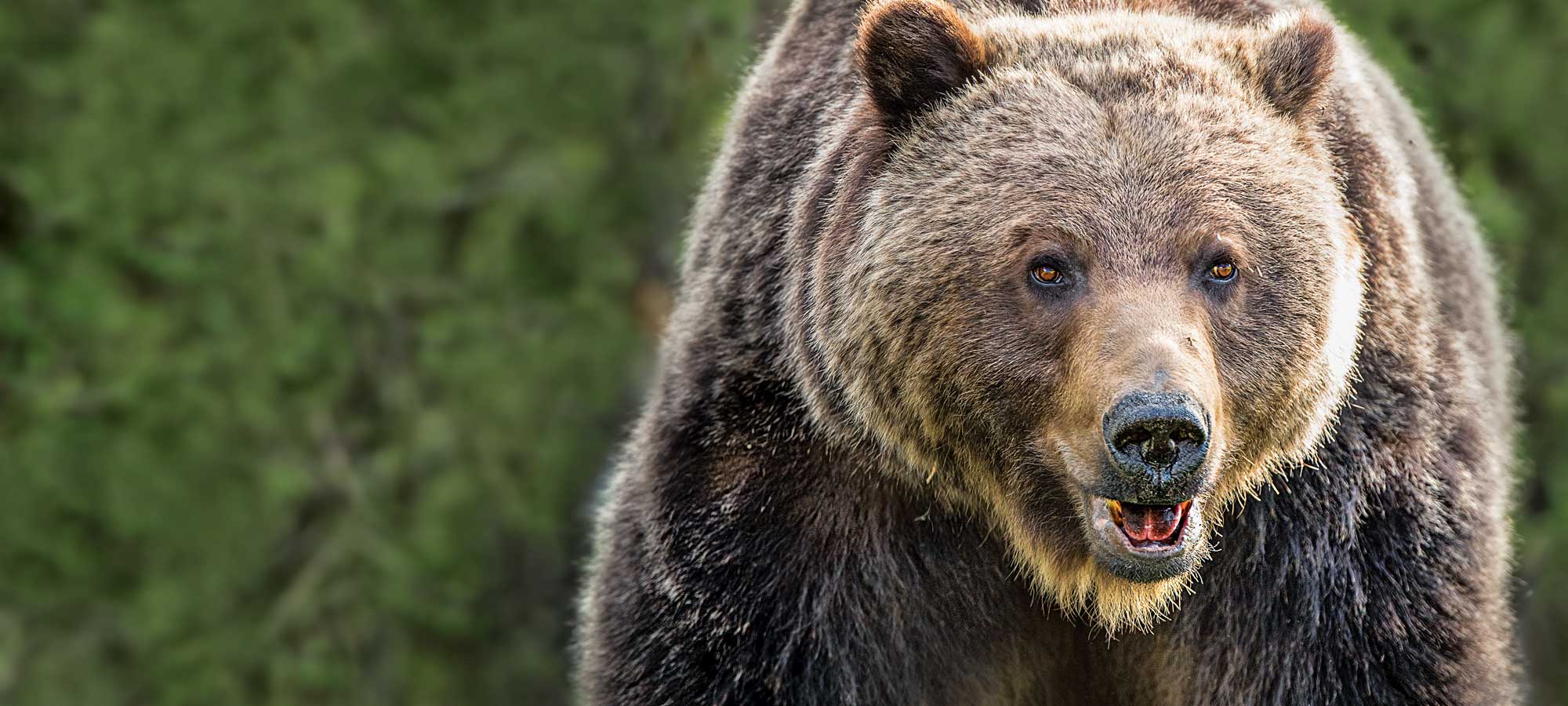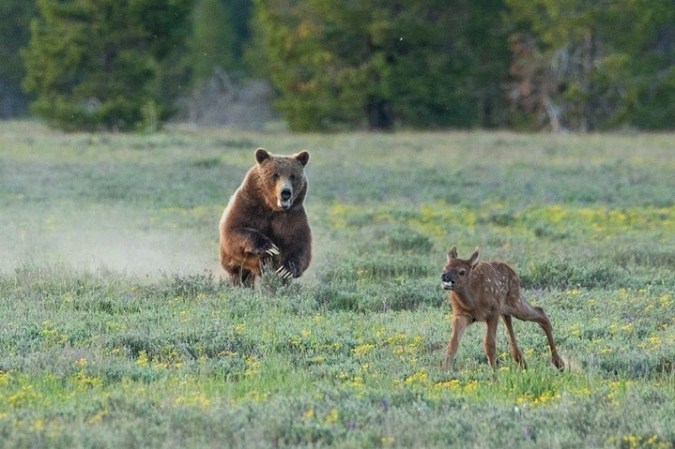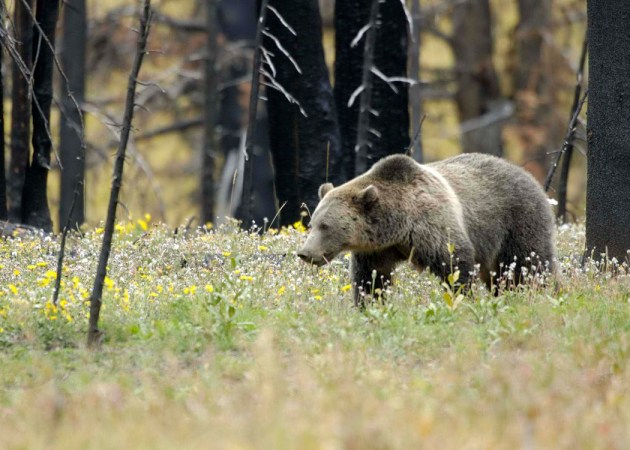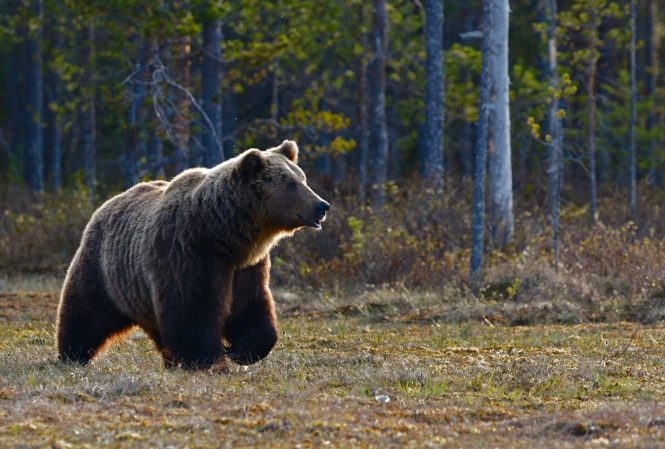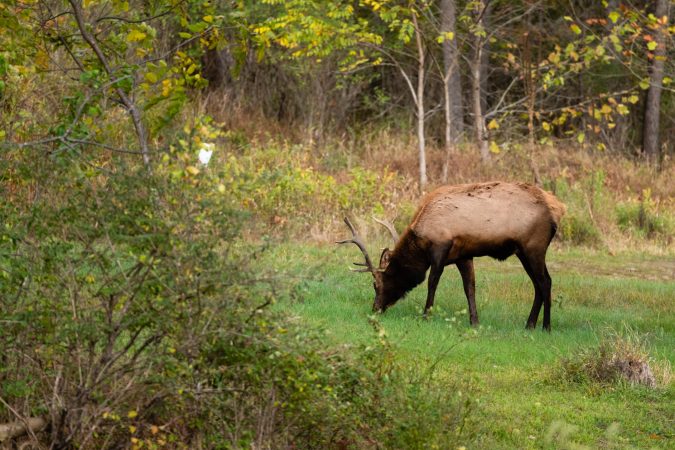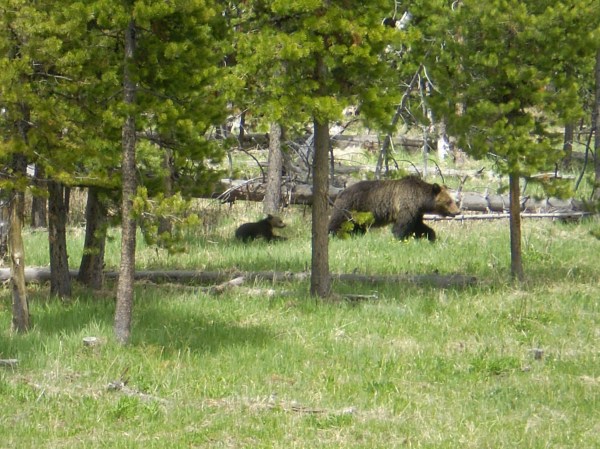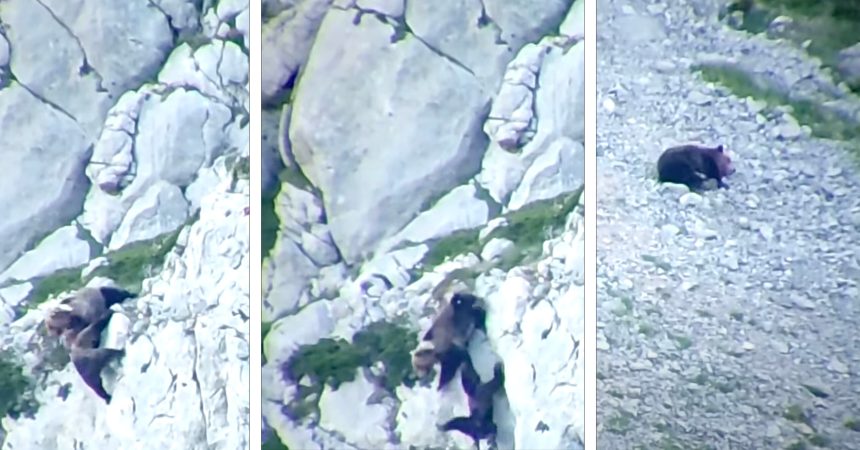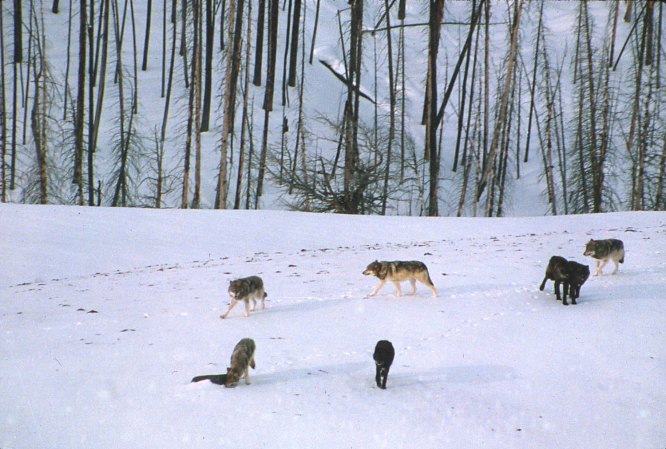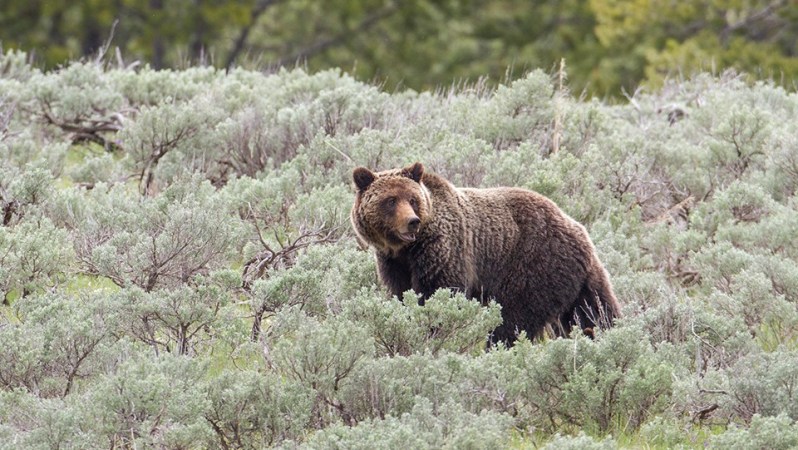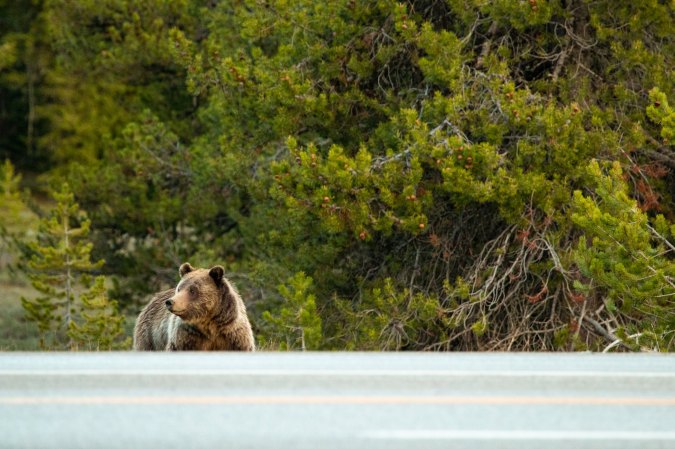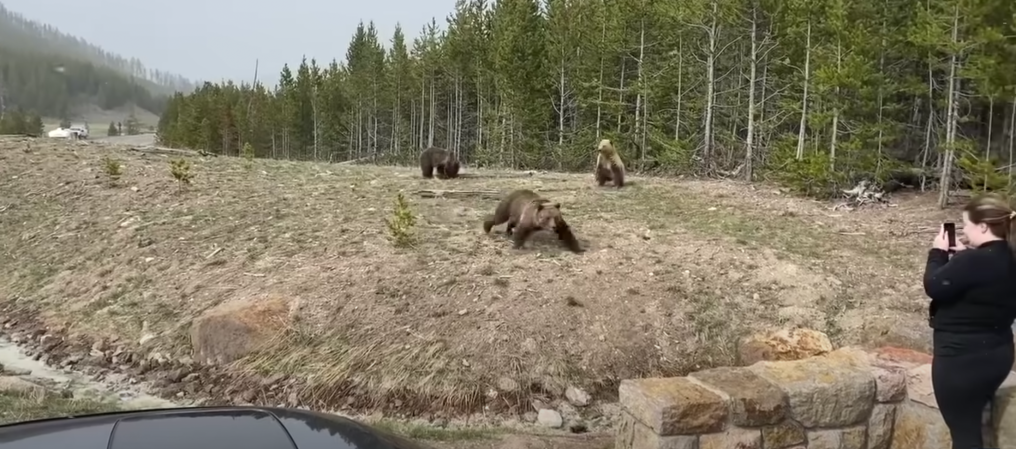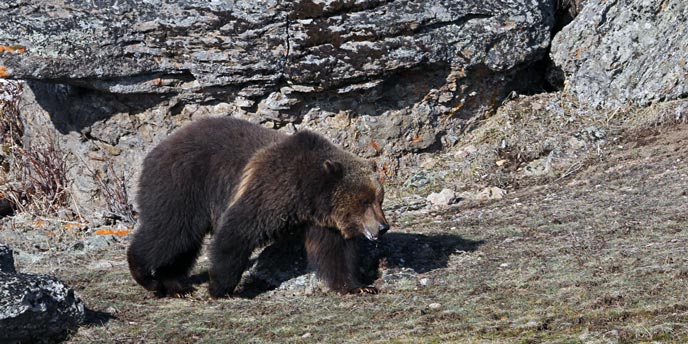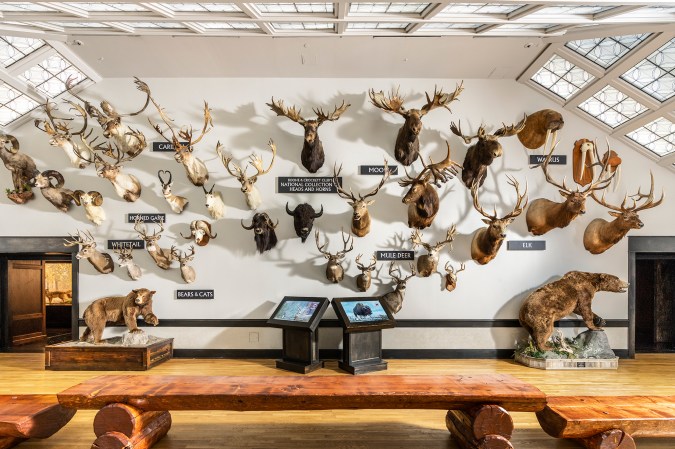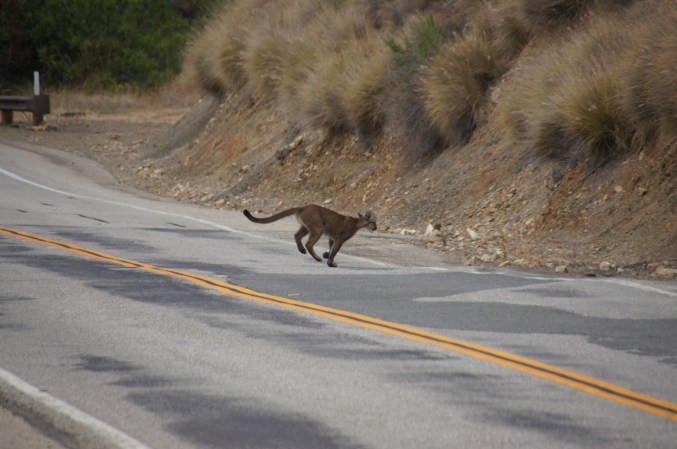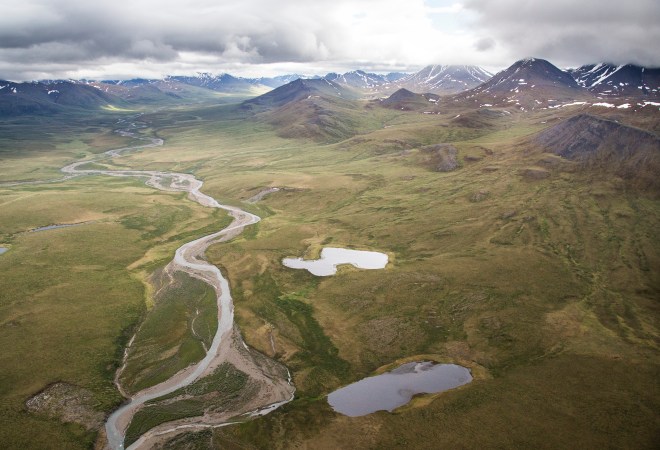Deep in the Teton Wilderness, near the southeast corner of Yellowstone National Park, Bond Isaacson, a 30-year-old hunter from North Carolina, loaded quarters from his first elk onto a packhorse with the help of his guide. The horse spooked. When Isaacson looked up, a big sow grizzly stood less than 20 yards away. “Hey, bear!” the guide yelled, frantically waving his arms. “Git bear! Git!” Isaacson’s hunting partner waved and hollered too. The grizzly popped its jaws and stepped toward them. The guide had no sidearm. The second hunter’s rifle was 10 yards away, leaning against a stump. The bear circled downwind. Now the three men stood between the grizzly and the elk carcass. Isaacson drew his .300 Win. Mag. from a scabbard on the packhorse. With a shaky voice he asked, “What should I do?” “Give it a warning shot,” the guide said, and Isaacson put a round in the dirt a few inches from the grizzly’s front claws. Then the bear charged. “Shoot it!” the guide yelled. “Shoot it!” The second shot toppled the grizzly midrun. She dropped 8 yards from the three men—and one freaked-out horse. Mike Deming, editor of Sportsman’s News and a family friend of Isaacson’s, had helped plan the hunt and was with Isaacson in camp. He wasn’t there during the attack, and he was curious to see the scene for himself. So the next day, Deming hiked a ridgeline to glass the area around Isaacson’s kill. He spotted a big boar grizzly feeding on the elk carcass and three smaller bears waiting their turn.
The Isaacson/Deming party saw more than a dozen grizzlies on their seven-day elk hunt. They camped on the fringe of Yellowstone National Park, after a 19-hour horseback ride into the backcountry, near where the Teton and Washakie Wilderness areas meet. A mother and two cubs were run from camp nightly with 12-gauge flashbang rounds. A fourth bear wandered into a hunter’s tent. Deming has hunted and killed three brown bears in Alaska and Canada, and more than 30 black bears throughout a lifetime hunting the West. He’s not the kind of guy who spooks easily. “But hunting near Yellowstone scares the living crap out of me,” he says. “Bears are everywhere.”
The grizzly Isaacson shot was the 33rd recorded bear death in the Greater Yellowstone Ecosystem in 2017. By the end of the year, 56 grizzlies made the list.
The Comeback
Forty years ago, you’d have been hard-pressed to see a Yellowstone grizzly anywhere but the park dump. Thanks to a litany of changes made by locals and state and federal wildlife managers, and the strict protections afforded under the Endangered Species Act, the return of the Yellowstone grizzly is one of the great American conservation success stories. Much of the funding for such a large-scale recovery effort was paid for by hunters. Wyoming has contributed more than $50 million, more than any other single state or agency, to the grizzly conservation effort. That money comes almost exclusively from Pittman-Robertson funds, which are raised from an excise tax on ammunition, firearms, and archery equipment.
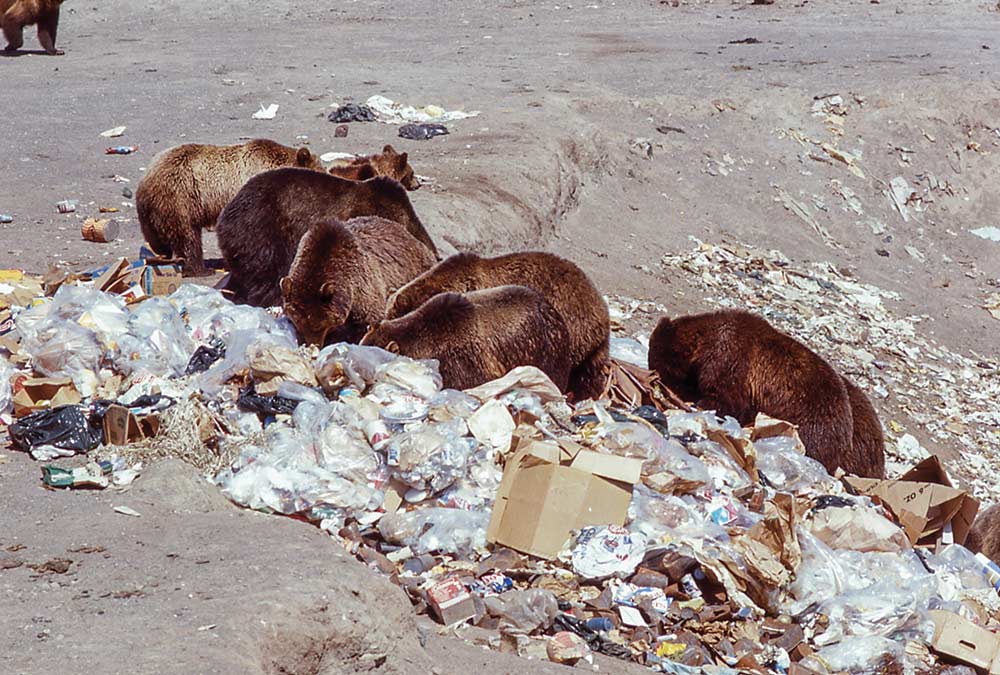
Last summer, Secretary of the Interior Ryan Zinke delisted the Yellowstone bears, effectively turning their management over to the states. Shortly thereafter, Idaho, Montana, and Wyoming announced their intention to explore hunting seasons for grizzlies. Montana decided against it for 2018. At press time, Idaho plans to offer a single grizzly tag, and Wyoming—which gets the boar’s share of tags because most of the Yellowstone bears live within its borders—is moving full steam ahead. As many as 24 tags could be issued for a four- to six-week season starting this September. Many consider a well-regulated hunt to be proof of success for the Endangered Species Act and the North American Model of Wildlife Conservation—the management philosophy that states decisions should be based on science, that wildlife is held in the public trust, and that hunting is an important tool for conservation.
But there is also huge risk that comes with the proposed hunt. In this age of social media, where video from the backcountry can be shared with millions, the wrong type of footage could potentially sway public opinion against grizzly hunting, and even big-game hunting in general.
Yet the best wildlife science on bears supports a highly regulated hunting season for Yellowstone-area grizzlies—as does the experience of hunters like Isaacson, Deming, and the locals of northwest Wyoming, who overwhelmingly support a hunt. To understand how killing grizzlies in a regulated hunt might actually help them, you have to wrap your head around the complex calculus of known bear mortality, or the science of grizzly deaths.
Frank van Manen, supervisory research biologist with the Interagency Grizzly Bear Study Team, United States Geological Survey, leads a group formed by the Department of the Interior in 1973 (the same year the Endangered Species Act was passed) that monitors and studies Yellowstone grizzlies. Team members are scientists who represent the National Park Service, U.S. Fish and Wildlife Service, U.S. Forest Service, Eastern Shoshone and Northern Arapaho tribes, and the states of Idaho, Montana, and Wyoming.
The best bear habitat in and around Yellowstone has been dubbed the Demographic Monitoring Area, or DMA. It’s a vast landscape of 25,000 square miles (about the size of Vermont, New Hampshire, and Massachusetts combined). Based on a memorandum of understanding between the states and the feds, bear numbers can be controlled by state-managed hunting programs to maintain a long-term average population of 674 grizzlies. That number isn’t arbitrary. It is how many bears can thrive in the Greater Yellowstone Ecosystem.
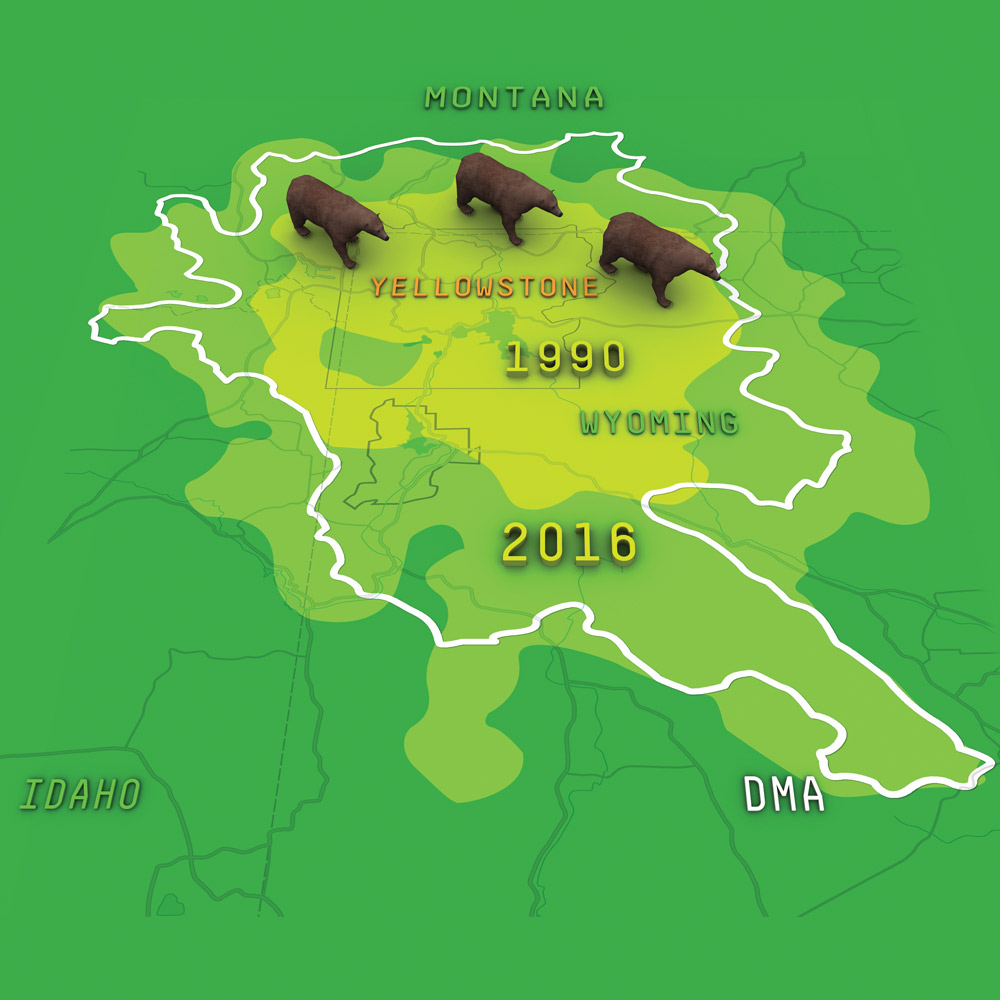
“This is the best bear habitat in the region,” van Manen says, “and it’s 94 percent occupied.” In fact, it’s been that way since the mid-2000s, when the population stabilized at about 700. The area is so saturated that grizzlies have expanded their range—tripling it in the last 20 years—and are now coming into regular contact with ranchers, hikers, homeowners, and hunters.
Last year, Wyoming Game and Fish captured 31 grizzly bears in conflict situations, and 11 of those bears were destroyed by the state. Four people were injured in bear encounters. In the past 10 years, there have been 29 grizzly-related injuries and five human deaths in Wyoming, plus one death in Montana.
Brian Nesvik, chief game warden of Wyoming Game and Fish and the public face of the state’s grizzly management plan, draws a direct line between there being more bears and the increase in human-grizzly conflicts.
“A reality of recovery is more bears in the ecosystem, which means expansion into new areas and increased contact with people,” he says. “Some years are worse than others, based on weather conditions, available food sources, and travel patterns. But over time, as the population has increased, the number of conflicts with humans has increased. From 1985 to 2010, there were no mortalities of humans by grizzlies. Since 2010, there have been six. The change is there are more bears.”
Van Manen’s team has also documented a decline in survival rates of cub and yearling bears since the early 2000s. As the habitat fills up with grizzlies, young bears are more likely to be killed by older boars over territory and easy food, like Isaacson’s elk carcass. This is troubling because grizzlies have the second-slowest reproduction rate of any mammal in North America. Cubs will stay with their mother for 2 ½ to 3 ½ years, during which time mama won’t mate.
A spike in cub and yearling female deaths could be catastrophic for the overall bear population. Hunting old boars could ease the territorial pressure on young sows. Biologists and managers with the state of Wyoming have considered all this and come up with a hunt plan that is—without question—the most highly regulated public hunting program ever devised in North America. And the regulations need to be tight, because the world will be watching.
Cecil Effect
Three years ago, Cecil the Lion garnered worldwide attention after a Minnesota dentist killed the 13-year-old cat outside Hwange National Park in Zimbabwe. The well-known lion was a favorite of photo tourists and animal-rights fundraisers. To try and quell the public firestorm, the Obama administration halted all lion trophy imports to the United States, effectively shutting out 75 percent of Africa’s lion hunters and the dollars they bring to big-cat conservation programs across the continent.
A year later, an Ohio hunter killed a bear with a spear on camera in Alberta, Canada. The footage went viral for all the wrong reasons. Alberta moved quickly to ban spear hunting outright.
Last year, British Columbia shut down its grizzly hunt after a protracted debate was kicked off by anti-hunting advocates who shared a particularly bloody video on Facebook. The video (which was not confirmed to have been taken in British Columbia) shows a grizzly being shot several times and sliding down a mountainside, leaving long red streaks in the snow.
British Columbia has about 15,000 grizzlies, or 25 percent of all grizzlies in North America—a population that’s healthy by any scientific measure. Shutting down the hunt had nothing to do with wildlife science, as government officials admitted. It was political: an anti-hunting movement launched with the help of a gory video. “It is no longer socially acceptable to the vast majority of British Columbians to hunt grizzly bears,” a provincial official told the press.
As Outdoor Life contributor Ben Long wrote at the time: “A decade ago, the killing of a grizzly bear would have had one or two witnesses: a hunter and perhaps a guide or companion. Today, killing a grizzly bear can be seen by millions of viewers on social media who won’t know the context of the hunt or the game-management reasoning behind it.”
The spotlight will be even brighter around Yellowstone, where international tourists are bused in every summer by the tens of thousands. Bears are named, and tranquil photographs of sows with cubs fill up postcard racks.
“We as hunters need to understand this is a highly controversial activity,” says Randy Newberg, a Montana hunter, television host, and outspoken public-land advocate with a long history of covering bear issues. “There’s going to be a lot of public scrutiny of this hunt, and if we screw it up, if bears are relisted, we’ll never get another chance.”
For environmental organizations, grizzlies are big business, Newberg says. Groups like the Sierra Club, the Center of Biological Diversity, and Earth Justice, which have all filed lawsuits to relist bears, raise big dollars from their supporters when charismatic critters, like a mama grizzly and her cubs, are featured in fundraising pamphlets. If hunting is legalized around Yellowstone and something goes wrong, whatever the cause, hunters will be the first to be blamed, Newberg says.
“If anyone thinks what happened in British Columbia can’t happen here, pull your head out to where the air is fresh,” he says.
He’d like to see grizzly hunting cordoned off to the most remote, backcountry locations possible, away from the long lenses of photo tourists, as well as a high application fee for tags, and possibly an early-spring season so older boars, which emerge from dens first, can be targeted specifically.
“It’s tempting to just flip antis the bird and say, ‘Too bad, it’s legal.’ But contrary to what we might like, hunters aren’t going to decide the future here. The court of public opinion will.”
Wyoming’s Grizzly Hunt
In designing their hunt, Wyoming officials have considered the science and social implications should something go wrong—like a famous bear getting killed.
To sustain an optimal bear population on the habitat available inside the DMA, the allowable annual mortality is 9 percent for sows and 20 percent for boars. That translates to hunting tags only when the previous year’s total bear population, and the estimated bear deaths, are factored into the equation. This stat includes any mortalities, such as bears killed in vehicle collisions, fights with other bears, self-defense kills by hunters, and problem bears killed by officers.
So, to calculate the 2018 grizzly season tags, biologists first looked at the total number of bears in the ecosystem in 2017: 718. In order to maintain healthy population levels, 50 adult males and 22 adult females could die from any cause. That same year, researchers documented and estimated that 33 male bears, 20 females, and 12 dependent cubs or yearlings died. This left a total of 19 possible bears in Montana, Idaho, and Wyoming to be killed during a 2018 hunting season. Because 58 percent of the Yellowstone bears live in Wyoming, the Cowboy State will receive 58 percent of the tags, or 12 total—10 boar tags and two sow tags. Only two tags will be released at a time in the six units that make up the DMA, to ensure no more than two sows are ever killed by hunters. Sows with cubs are off-limits, and no traps, dogs, or bait are allowed.
Hunters who draw will be required to take a grizzly education class and carry a satellite messenger to report their kill and the bear’s sex as soon as it happens. After the kills are verified by Game and Fish, two more licenses will be issued, so long as two sows have not been killed. Once the two-sow limit is reached, the hunt will be closed regardless of how many boar tags are still available.
No hunting will be allowed within a quarter mile of U.S. highways in the monitoring area, including roads approaching Yellowstone and Grand Teton National Park, where bear viewing draws big crowds. Areas that border Grand Teton are also off-limits, to prevent hunters from killing a bear that’s well-known to tourists.
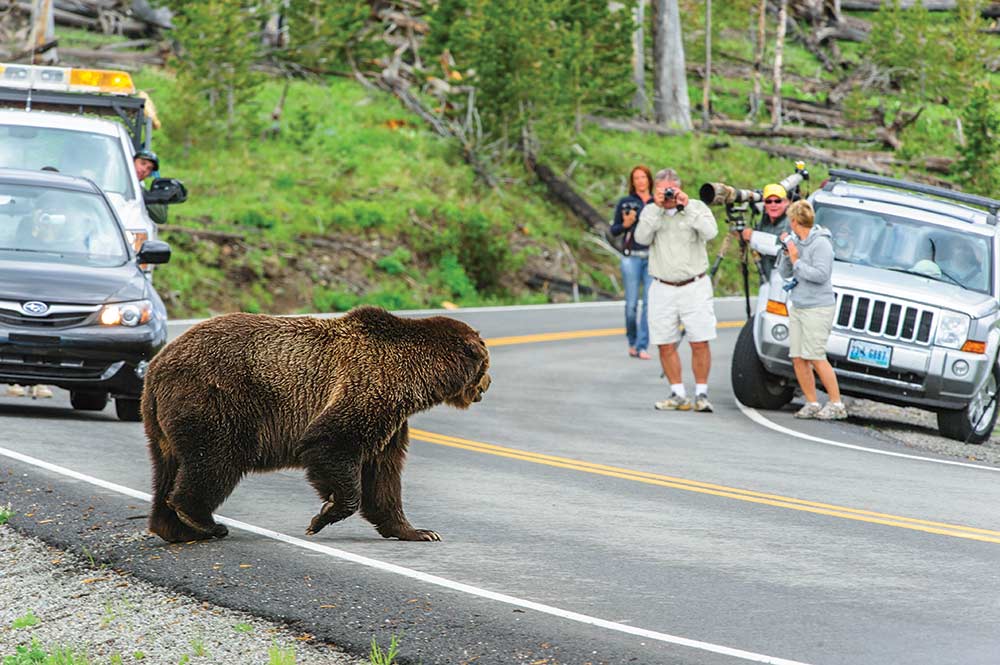
Outside the DMA, the state is free to set up hunting regulations independent of federal oversight. In these areas, Wyoming plans to issue an additional 12 tags, which they hope will act as a firewall to prevent grizzlies from traveling farther east and south—and into more conflicts with people. Here, the regulations are much more relaxed. This area includes the foothills, prairie, and edges of towns like Cody and Lander. Bears here are not monitored by the Interagency Study Team, and there’s no good count on how many grizzlies eke out a life away from the prime habitat of the DMA. Wyoming officials hope the bulk of these tags will be punched on problem bears close to town. Baiting would be allowed in these zones at the discretion of Game and Fish, Nesvik says, and would only be permitted to attract a known problem bear.
Just southwest of Cody, along Route 291, rancher Tom Bales lives with these bears. Up and down this road—from town all the way to Buffalo Bill Reservoir 20 miles away—subdivisions have sprouted up over the last few years. This human expansion doesn’t appear to be slowing down either. Riding high on energy and tourism, Cody is among the fastest-growing towns in the state. The county recently put up a $28,000 electric fence around the dump.
Bales has about 500 acres of irrigated ground, and he now regularly gets trail camera photos of bears in his corn. Between his pictures, and those taken with his neighbor’s cameras, he thinks four or five different grizzlies frequented one 40-acre cornfield last year. The year before, they documented 16 grizzlies, including nine bears spotted in a field at one time.
“We probably lose three to five acres a year to bears,” Bales says.
On Carter Mountain, in the Absaroka Front, Bales runs a few hundred head in a cow-calf operation with his brother. Two or three times a week the brothers ride their allotment, looking for carcasses. Bears, Bales has found, tend to turn a calf inside out—the hide peeled off and piled up like a deer skin on a butcher’s floor. He takes the carcasses to Game and Fish, which determines if it was the work of wolves or bears. Grizzly kills are reimbursed 3.5 to 1 (for every confirmed bear kill, a rancher is reimbursed for 3.5 missing cows). Last year they had 19 confirmed kills, and another 30 or 40 head went missing.
“So many people think the farmers and ranchers are against the bears,” Bales says. “We’re not. Bears have their place. We have to learn to live with them. What bothers me is they don’t have a good way to estimate the population. Something needs to be done.”
Game warden Nesvik says the answer is hunters.
“Our goal is to have hunters deal with all our problem bears. We believe it’s better for hunters to manage bears than us as a government agency,” he says. “The North American Model of Wildlife Management, which has been successful for more than 80 years, includes hunting. When there’s biological justification and public support, the state needs hunters.”
But Nesvik and the state of Wyoming don’t get the last word here. The decision on whether grizzly hunting will be allowed rests with a federal court in Montana.
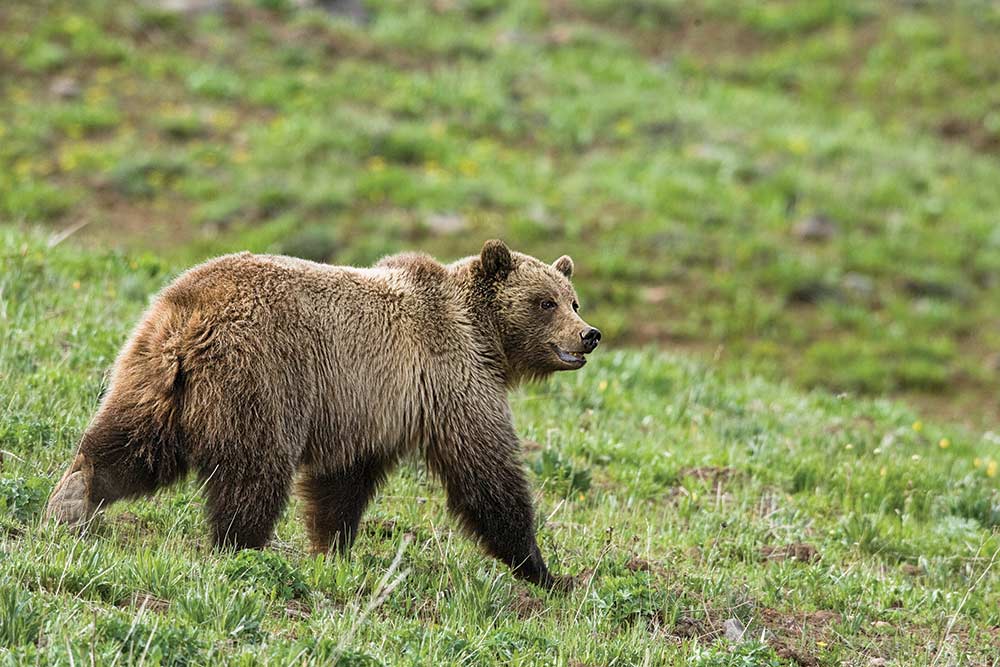
Bear of a Court Case
Some activists who oppose a hunt have countered that the genetic health of the Yellowstone bears—all offspring of those few lucky bears that survived the 1970s—is reason enough to leave them alone. There are six “islands” of recovering bear populations in the Lower 48, and they need to connect to each other to ensure the long-term genetic health of the species, or so the argument goes. But that science doesn’t stand up, says van Manen. Other than the Yellowstone bear population, the U.S. bear subgroups connect to much larger populations in Canada. The Yellowstone bears have enough genetic variation among them to be sustainable long-term, he says. Even still, with or without hunting, bears in the North Continental Divide and the Yellowstone grizzlies are positioned to connect in the next 10 years, he says. Less than 70 miles separate them now.
“From a biologist’s perspective, the proposed hunt isn’t a threat to grizzlies,” van Manen says. “In a way, it’s sad that hunting gets so much attention, as larger issues of land use—landscape level changes between Yellowstone and the North Continental Divide population—could affect them. [And that] gets lost in the debate.”
Back in 2007, the U.S. Fish and Wildlife Service submitted a formal rule to delist grizzlies but was sued by environmental groups, which contended that the government scientists did not consider the effects of climate change on an important grizzly food source. The Interagency Grizzly Bear Study Team investigated the issue and found it wasn’t a threat. In 2016, the Obama administration proposed delisting the Yellowstone grizzlies yet again, but after a torrent of 650,000 public comments, any action was delayed.
Once Zinke took the Secretary of the Interior position, delisting the Yellowstone grizzlies was among his first actions. Yet before the ink on the order was dry, anti-hunting advocates filed lawsuits to stop the process in federal court. A recent ruling on delisting wolves in the Great Lakes may help bolster the anti-hunters’ case too.
In hopes of settling all the legal issues surrounding the Yellowstone bears before this fall’s hunting season, a U.S. district judge in Montana earlier this year ordered attorneys on both sides “to put their sprawling arguments into a single set of briefs for a hearing in August,” according to the Missoulian newspaper. The judge’s ruling, and the inevitable appeals process, will decide who gets to manage the Yellowstone bears and, more important, by whose definition an Endangered Species Act animal is no longer endangered.
A Changing Landscape
Back in 2006, Robert Fernandes, a hunter from California, traveled to northwest Wyoming to hunt elk. On the drive from the airport to the lodge, he was required to stop and buy bear spray. After arrival, the guide launched into a speech on bears and how if any hunter made the mistake of killing one, they would be prosecuted like they had murdered a human.
“On the one hand, they told us how the area was covered up with grizzlies, and on the other, they said we can’t defend ourselves without risk of fines or jail,” Fernandes says.
In many ways, this attitude that grizzlies must be protected at all costs is still common in the West. Bond Isaacson, who had two witnesses to the charge he stopped, says he was nonetheless questioned like a criminal. Game and Fish took a helicopter to the scene of the killing and took parts of the bear, photos, and a shell casing. The warden found only one of the two spent shells and took that as a sign that something fishy had unfolded, as Isaacson tells the story. “I was back in North Carolina, and the game warden called me and said, ‘I have a feeling you’re not being honest with me.’ Here I thought I saved my own life. The other hunter and the guide thanked me for saving their lives. They were pretty emotional about it. Now all of a sudden, I’m under investigation?”
The Park County prosecutor closed a criminal investigation against him in December, citing insufficient evidence, with the remark, “Isaacson, although uncooperative to some degree on the casings, appears to [have acted in] self-defense.”
Part of the resistance to the grizzly hunt may have to do with this seismic shift in perspective. Last year, Yellowstone grizzlies had nearly the same legal protections as humans. This year, some might be hunted and killed as game animals. This charismatic mega-fauna, one of the great symbols of the American West, for the first time in 40 years could be someone’s hunt of a lifetime.
The appeal of killing a grizzly isn’t something every hunter understands either, says hunting-show host and public-land advocate Newberg, who killed a brown bear in southeast Alaska with his grandfather 12 years ago.
“For a lot of people, there’s an element of danger to hunting grizzlies, whether real or perceived, much like the Big Five in Africa,” he says. “That appeals to some, but not to others.”
For some, there’s the attraction of a hunting adventure in a stunning landscape. If the Wyoming hunt happens, it will take place in “some of our finest backcountry in the Lower 48,” Newberg says.
Yet the larger issue of the grizzly’s long-term survival, according to lead bear biologist van Manen, is the landscape-level change happening throughout the Intermountain West. Take Bozeman, Mont., which sits between the Yellowstone and North Continental Divide bear populations, in that 70-mile stretch that will soon be traveled by grizzlies. As Mountain Journal reported last year, Bozeman will be the size of Salt Lake City by 2041, and have more than 420,000 people—the size of present-day Minneapolis—by 2065, if growth trends continue.
“What has been proposed in Wyoming is not a threat [to the grizzly population],” van Manen says. “The development of mountain valleys, the roads and homes associated with development, and more frequent backcountry use—those are threats. Bears can do quite well in many situations, they respond to change well. But the more we infringe on productive bear habitat, the closer we come to their tipping point.”
Read Next: The Story Behind the Scout Ridge Bear Attack
Grizzly bear survival is dependent on large-scale tracts of unspoiled, wild lands. Grizzlies, in a way, indicate how wild a landscape is and are key in determining how wild we want a landscape to be. They’re another reason for ensuring public lands remain public and restrictions on development of the backcountry remain in place. Grizzlies have already maxed out their allotted habitat in the northwest corner of Wyoming, and their numbers will be controlled.
Grizzlies will be killed. The question is whether those bears are to be killed in a state-run program of trappers and marksmen, paid for with taxpayer dollars, or by public hunters who will pay for the privilege themselves.
“At the end of the day, our hope, and my belief, is that an overwhelming majority of hunters are ethical, are good conservationist outdoorsmen, who understand the size and scope of this opportunity before them,” chief game warden Nesvik says. “It’s not without risks, but we have to give hunters the chance to do the right thing.”
